![]() Johor
Johor
![]() Malacca
Malacca
![]() Negeri Sembilan
Negeri Sembilan
![]() Selangor
Selangor
![]() Perak
Perak
![]() Kedah
Kedah
![]() Perlis
Perlis
![]() Pahang
Pahang
![]() Terengganu
Terengganu
![]() Kelantan
Kelantan
![]() Penang
Penang
![]() Sabah
Sabah
![]() Sarawak
Sarawak
![]() Kuala Lumpur
Kuala Lumpur
![]() Labuan
Labuan
![]() Putrajaya
Putrajaya

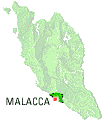 Melaka is located on the Western Coast
of Peninsular Malaysia facing the Straits of Melaka, about 147
kilometers from Kuala Lumpur and 245 kilometers from Singpore.
Melaka is actually found sandwiched between the states of Negeri
Sembilan and Johor. It can be reached by excellent roads from
Kuala Lumpur and Singapore. Internally it is serviced by a very
good network of roads leading to all the historical places of
interest. It covers and area of 658 square kilometers and is
divided into three districts namely Alor Gajah, Melaka Tengah and
Jasin.
Melaka is located on the Western Coast
of Peninsular Malaysia facing the Straits of Melaka, about 147
kilometers from Kuala Lumpur and 245 kilometers from Singpore.
Melaka is actually found sandwiched between the states of Negeri
Sembilan and Johor. It can be reached by excellent roads from
Kuala Lumpur and Singapore. Internally it is serviced by a very
good network of roads leading to all the historical places of
interest. It covers and area of 658 square kilometers and is
divided into three districts namely Alor Gajah, Melaka Tengah and
Jasin.
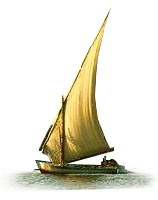 Islam and the Golden Age of
Malacca
Islam and the Golden Age of
Malacca
1400 AD - 1511 AD
Until the 15th century, the Hindu kingdoms of peninsular Malaysia
were largely overshadowed by neighboring kingdoms in Cambodia and
Indonesia. The strongest of these kingdoms was called Srivijaya,
and the records of Chinese, Indian, and Arab traders laud it as
the best trading port in the region. It was the first great
maritime kingdom in the Malay archipelago, and other ports
quickly emulated its success. At some time around the 13th
century, as other entrepots emerged, Srivijaya's influence
declined. The lack of a strong central power, coupled with the
ever-present nuisance of pirates, amplified the need for secure,
well-equipped port in the region. Fate would make this port the
city of Malacca.
According to the Malay Annals, Malacca was founded in 1400 by a fleeing Palembang prince named Parameswara. Its rise from a village of royal refugees to a wealthy kingdom was swift. Perfectly located for trade, within 50 years it was the most influential port in Southeast Asia. At any one time, ships from a dozen kingdoms great and small could be seen in the harbor. With these traders came Islam, and Malacca's rulers now referred to themselves as "sultans." The sultans were the heads of a highly organized municipal government, whose main purpose was to facilitate trade. Every incoming ship was met by a multilingual harbor capitan, whose staff would see to all the vessel's needs. There were also gaurded storehouses where goods from the interior and abroad could be stored until traders arrived. Most importantly, Malacca was able to control what had always been the bane of trade in the Straits area - pirates. By building alliances with outlying tribes and ports, Malacca established a kind of regional "navy" that policed the local waters and escorted friendly vessels.
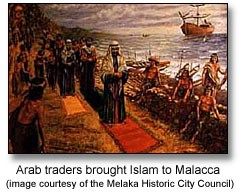
With the success and power it enjoyed, Malacca came to control the entire west coast of the Malay peninsula, the kingdom of Pahang, and much of Sumatra. At the height of its power, however, fate would ruin the city as quickly as it built it up. In 1511, the Portugeuse arrived, beginning a colonial legacy that would last well into the 20th century.
The history of Malacca is largely the story of the city for which it is named, and the story of the city of Malacca begins with the fascinating and partly legendary tale of the Hindu prince Parameswara.
The Malay Annals relate that Parameswara was a fourteenth-century Palembang prince who, fleeing from a Japanese enemy, escaped to the island of Temasik (present-day Singapore) and quickly established himself as its king. Shortly afterward, however, Parameswara was driven out of Temasik by an invasion, and with a small band of followers set out along the west coast of the Malay peninsula in search of a new refuge. The refugees settled first at Muar, but they were quickly driven away by a vast and implacable horde of monitor lizards; the second spot chosen seemed equally inauspicious, as the fortress that the refugees began to build fell to ruins immediately. Parameswara moved on. Soon afterward, during a hunt near the mouth of a river called Bertam, he saw a white mouse-deer kick one of his hunting dogs. So impressed was he by the deer's defiant gesture that he decided immediately to build a city on the spot. He asked one of his servants the name of the tree under which he was standing and, being informed that the tree was called a Malaka, gave that name to the city. The year was 1400.
Although its origin is as much romance as history, the fact is
that Parameswara's new city was situated at a point of enormous
strategic importance. Midway along the straits that linked China
to India and the Near East, Malacca was perfectly positioned as a
center for maritime trade. The city grew rapidly, and within
fifty years it had become a wealthy and powerful hub of
international commerce, with a population of over 50,000. It was
during this period of Malacca's history that Islam was introduced
to the Malay world, arriving along with Gujarati traders from
western India. By the first decade of the sixteenth century
Malacca was a bustling, cosmopolitan port, attracting hundreds of
ships each year. The city was known worldwide as a center for the
trade of silk and porcelain from China; textiles from Gujarat and
Coromandel in India; nutmeg, mace, and cloves from the Moluccas,
gold and pepper from Sumatra; camphor from Borneo; sandalwood
from Timor; and tin from western Malaya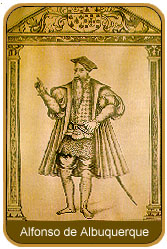
 Unfortunately, this fame arrived at just
the moment when Europe began to extend its power into the East,
and Malacca was one of the very first cities to attract its
covetous eye. The Portuguese under the command of Afonso de
Albuquerque arrived first, taking the city after a sustained
bombardment in 1511. The Sultan fled to Johor, from whence the
Malays counterattacked the Portuguese repeatedly though without
success. One reason for the strength of the Portuguese defense
was the construction of the massive fortification of A Famosa,
only a small portion of which survives today.
Unfortunately, this fame arrived at just
the moment when Europe began to extend its power into the East,
and Malacca was one of the very first cities to attract its
covetous eye. The Portuguese under the command of Afonso de
Albuquerque arrived first, taking the city after a sustained
bombardment in 1511. The Sultan fled to Johor, from whence the
Malays counterattacked the Portuguese repeatedly though without
success. One reason for the strength of the Portuguese defense
was the construction of the massive fortification of A Famosa,
only a small portion of which survives today.
A Famosa ensured Portuguese control of the city for the next one hundred and fifty years, until, in 1641, the Dutch invested Malacca after an eight-month siege and a fierce battle. Malacca was theirs, but it lay in almost complete ruin. Over the next century and a half, the Dutch rebuilt the city and employed it largely as a military base, using its strategic location to control the Straits of Malacca. In 1795, when the Netherlands was captured by French Revolutionary armies, Malacca was handed over to the British to avoid capture by the French. Although they returned the city to the Dutch in 1808, it was soon given over to the British once again in a trade for Bencoleen, Sumatra. From 1826, the city was ruled by the English East India Company in Calcutta, although it experienced Japanese occupation from 1942 to 1945. Independence did not arrive until 1957, when anti-colonial sentiment culminated in a proclamation of independence by His Highness Tunku Abdul Rahman Putra Al-Haj, Malaysia's first Prime Minister.
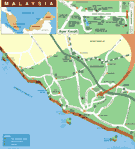
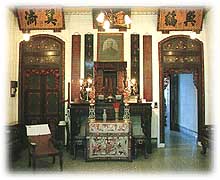 As a trading port, Malacca became a
meeting point for every seafaring nation. Persians, Arabs,
Tamils, Malabarese and Bengalis from the west; Javanese, Sudanese
and Sulus from the archipelago; Chinese, Thais, Burmese as well
as Khmers ventured here in search of profit through trade, piracy
and plunder. Each in turn left something of their own culture to
be forged and blended into a new and unique mix.
As a trading port, Malacca became a
meeting point for every seafaring nation. Persians, Arabs,
Tamils, Malabarese and Bengalis from the west; Javanese, Sudanese
and Sulus from the archipelago; Chinese, Thais, Burmese as well
as Khmers ventured here in search of profit through trade, piracy
and plunder. Each in turn left something of their own culture to
be forged and blended into a new and unique mix.
Malacca today is a land of many sights and attractions, rich in
colour and contrasts. The multi-racial population live and work
in harmony, yet preserving the traditions and cultures unique to
each race.
Malacca's fascinating cultures are strongly evident everywhere
one goes. From the typical roadside stall to the royal palace,
the rich heritage of Melaka's cultural traits continue to
influence the lives of the people here.
Cultural diversity abound in the games played, in the savoury
food prepared, in the many art forms and pastimes, in the
colourful festivals that are reverently looked forward to and
indeed in the many facets of their lifestyles.
So rich and fascinating are the cultures that volumes have been written about them. Visitors to Malacca too, are often awe-inspired by the sheer fascination of the multi-faceted cultures.
As Islam is the official religion of Malaysia, this also applies
to Malacca but still provides the freedom of religion for all.
The mosques in Malacca has very unique architectural works that
can fascinate all. The churches and temples are also tourist
attractions in Malacca.
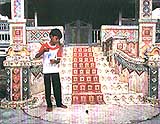 Malacca is a multi-racial place of
friendly, warm hearted people, comprising of Malays, Chinese,
Indians, Baba-Nyonya, Portuguese and Chitty.
Malacca is a multi-racial place of
friendly, warm hearted people, comprising of Malays, Chinese,
Indians, Baba-Nyonya, Portuguese and Chitty.
Malacca offers a broad range of flavours. The adventurous gourmet will be spoilt for choice with a selection including Malay, Western, Chinese, Indian, Thai or a rich melange of cuisines.
Malacca is also the birth place and home to Peranakan cooking, that exotic blend of Chinese and Malay savoury cuisines. Piquant Portuguese dishes are also exclusive on local menus, reflecting this community’s indelible influence on the state’s rich culture and cuisine. So, it’s a must to relish every bit of everything, when in Malacca.
![]() States
States
![]() Tourism
Tourism
![]() National Symbols
National Symbols
![]() History
History
![]() Geography
Geography
![]() Flora & Fauna
Flora & Fauna
![]() Economy
Economy
![]() Culture
Culture
![]() Festivals
Festivals
![]() Transportation
Transportation
![]() Accommodation
Accommodation
![]() Foreign Exchange
Foreign Exchange
![]() Food
Food
![]() Fruits
Fruits